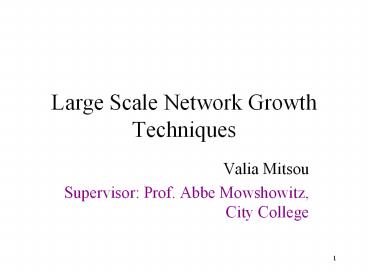Large Scale Network Growth Techniques - PowerPoint PPT Presentation
1 / 22
Title:
Large Scale Network Growth Techniques
Description:
It is useful to study binary graph operations that can be used in this concept ... of the order of n and this procedure can be realized within at most linear time. ... – PowerPoint PPT presentation
Number of Views:14
Avg rating:3.0/5.0
Title: Large Scale Network Growth Techniques
1
Large Scale Network Growth Techniques
- Valia Mitsou
- Supervisor Prof. Abbe Mowshowitz, City College
2
Network growth
- Two major directions of research
- Describe and explain how real-world networks grow
- Propose a new technique for building large
networks with good properties
3
Introduction
- A natural way networks in the real world are
built is by connecting smaller networks together
to form a larger one - It is useful to study binary graph operations
that can be used in this concept (two smaller
graphs are combined to create a larger one).
4
Outline
- Definitions of some basic graph operations that
can be used for creating a larger network from
two smaller ones. - We will examine the properties of the produced
network in terms of the smaller ones. - Diameter
- Vulnerability
5
Graph Operations
- Simple Operations The size of the resulting
graph is of the order of O(n1 n2). - Products The size of the resulting graph is of
the order of O(n1 n2).
6
Simple Operations
- Coalescence. A coalescence of two graphs G1 and
G2 is any graph obtained from the disjoint union
of G1 and G2 by merging one vertex from G1 and
one from G2. (Disjoint) - Union. The (disjoint) union of two graphs
G1(V1,E1), G2(V2,E2) is a graph G(V,E) where V
V1 U V2 and E E1 U E2. - Join. The join of two graphs G1(V1,E1), G2(V2,E2)
is a graph G(V,E) where V V1 U V2 and E E1 U
E2 U (x,y) x ? V1 y ? V2.
7
Coalescence
Union
Join
8
Products 1
- Cartesian Product. The cartesian product of two
graphs G1(V1,E1) and G2(V2,E2) is a graph G(V,E)
with V V1 x V2 and E (u1,u2)(v1,v2), where
(u1 v1 u2v2 ? E2) or (u2 v2 u1v1 ? E1). - Composition (or Lexicographic Product). The
composition of two graphs G1(V1,E1) and G2(V2,E2)
is a graph G(V,E) with V V1 x V2 and E
(u1,u2)(v1,v2), where (u1v1 ? E1) or (u1 v1
u2v2 ? E2).
9
Products 2
- Tensor Product (Direct Product, Categorical
Product, Cardinal Product, or Kronecker Product).
The tensor product of two graphs G1(V1,E1) and
G2(V2,E2) is a graph G(V,E) with V V1 x V2 and
E (u1,u2)(v1,v2), where u1v1 ? E1 and u2v2 ?
E2. - Co-normal Product (Disjunctive Product or Or
Product). The co-normal product of two graphs
G1(V1,E1) and G2(V2,E2) is a graph G(V,E) with V
V1 x V2 and E (u1,u2)(v1,v2), where u1v1 ?
E1 or u2v2 ? E2.
10
Products 3
- Compounding of Graphs. Roughly speaking,
compounding of two graphs G(V,E) and H is
obtained by taking V copies of H, indexed by the
vertices of G, and joining two copies Hu, Hv of H
by a single edge whenever (u,v) ? E. - Rooted Product. A special case of compounding.
The rooted product of a graph G(V,E) and a rooted
graph H is defined as follows take V copies of
H and for every vertex vi ? V identify vi with
the root node of the ith copy of H.
11
G1
G2
Cartesian
Co-normal
Composition
Rooted
Tensor
12
First TaskCompute the diameter
13
Table (simple operations)
14
Table (products)
n12l2 n22 l1 l1l2
15
Second TaskVulnerability of Large Scale
Networks
16
Parameters
- Knowledge of the adversary The information an
attacker has for the network. It is generally
reasonable to assume no a priori knowledge of the
network, however we will also examine the other
case. - Power of the adversary cost of mounting an
attack. Reasonable limitations - The attacker can undertake a small number of
nodes. - The time complexity of the attack should be a
relatively small function of n.
17
Definition of Vulnerability
- We say that a network is vulnerable for a
specific attacker if he can address an attack
that will isolate an at most logarithmic number
of nodes or edges which if we remove then the
network is disconnected into two pieces (not
necessarily connected components) of the order of
n and this procedure can be realized within at
most linear time. - Vulnerability can be divided into three classes
node, edge, and mixed node and edge.
18
Node Vulnerability
- A more formalized way to express node
vulnerability would possibly be the minimum
b-vertex separator problem - Definition Given a graph G(V,E) and a number
0 lt b ½, find a partition V into disjoint sets
A, B, C such that minA,B b V and no node
of A is connected to a node of B. We want to
optimize the size of the separator, i.e C.
19
Results on Minimum b-Vertex Separator Problem
- NP-hard.
- Inapproximable within 1 V1/2 e /OPT for any
egt0, even for graphs of maximum degree 3 (Bui and
Jones) - In planar graphs, a graph separator of size
O(vV) can be found in polynomial time (Lipton
and Tarjan)
20
Further Research
- Examine the case of networks created using graph
operations. Suppose that - The adversary knows the graphs from which the
network was created. - The graphs are vulnerable
- Can he take advantage of this information to
destroy the network?
21
Further Research
- Example For the composition product Cn x Cn 2n
nodes suffice to destroy the network. However it
cannot be considered as node vulnerable since
this amount is the sqrt of the total size of the
whole network.
22
Thank you!































